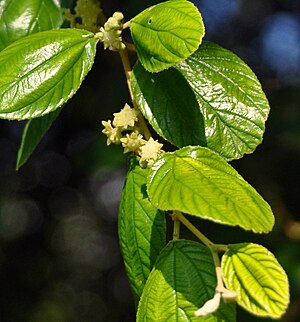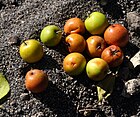Note: This is a project under development. The articles on this wiki are just being initiated and broadly incomplete. You can Help creating new pages.
Ziziphus mauritiana - Common jujube
Badarah is a much branched thorny tree that grows in the drier parts of India. The fruits are enjoyed by animals and man alike.
Contents
- 1 Uses
- 2 Parts Used
- 3 Chemical Composition
- 4 Common names
- 5 Properties
- 6 Habit
- 7 Identification
- 8 List of Ayurvedic medicine in which the herb is used
- 9 Where to get the saplings
- 10 Mode of Propagation
- 11 How to plant/cultivate
- 12 Commonly seen growing in areas
- 13 Photo Gallery
- 14 References
- 15 External Links
Uses
Relieves constipation, Relieves excessive thirst, Improves digestion strength, Nasal bleeding, Gastric, Blood disorders, Diarrhea [1]
Parts Used
Chemical Composition
Common names
| Language | Common name |
|---|---|
| Kannada | ಬೋರೇ Bore, ಎಲಚಿ Elachi |
| Hindi | Bara-bor, Kath ber, |
| Malayalam | Chirimullu, Ilanta |
| Tamil | Ilandai, Elandai |
| Telugu | Regi, Regu-pandu |
| Marathi | Boor |
| Gujarathi | NA |
| Punjabi | NA |
| Kashmiri | NA |
| Sanskrit | Karkandhu, Kola |
| English | Indian Jujube |
Properties
Reference: Dravya - Substance, Rasa - Taste, Guna - Qualities, Veerya - Potency, Vipaka - Post-digesion effect, Karma - Pharmacological activity, Prabhava - Therepeutics.
Dravya
Rasa
Madhura (Sweet), Amla (Sour)
Guna
Guru (Heavy), Snigdha (Oily)
Veerya
Sheeta (Cold)
Vipaka
Karma
Kapha, Pitta, Vata
Prabhava
Habit
Identification
Leaf
| Kind | Shape | Feature |
|---|---|---|
| Simple | Alternate | Distichous; stipular spines solitary or in pairs, straight or one of them recurved; nodes slightly enlarged around the leaf scars. |
Flower
| Type | Size | Color and composition | Stamen | More information |
|---|---|---|---|---|
| Axillary cyme | Bisexual | Greenish-yellow | 5 | n 15-20 flowered dense cymose axillary fascicles. |
Fruit
| Type | Size | Mass | Appearance | Seeds | More information |
|---|---|---|---|---|---|
| Drupe | 1 x 0.5 cm | Oblong-globose, yellow or orange when ripe; 1-2-celled | Seeds 1 or 2, compressed. | {{{6}}} |
Other features
List of Ayurvedic medicine in which the herb is used
Where to get the saplings
Mode of Propagation
How to plant/cultivate
Storage of the seed for 4 months to let it after-ripen improves germination. If facilities are available, stratification in sand for 60 - 90 days at 5°c is recommended. Scarification, extracting the seed from the stone, and treating it with sulphuric acid has also been recommended. To germinate, seeds need full sunlight. Seed should germinate in 3 - 4 weeks when the seed is left in stone, quicker if it is cracked, and only 1 week if it is carefully extracted. [5]
Commonly seen growing in areas
Tropical area, Dry deciduous forests.
Photo Gallery
References
External Links
- Ayurvedic Herbs known to be helpful to treat Relieves constipation
- Ayurvedic Herbs known to be helpful to treat Relieves excessive thirst
- Ayurvedic Herbs known to be helpful to treat Improves digestion strength
- Ayurvedic Herbs known to be helpful to treat Nasal bleeding
- Ayurvedic Herbs known to be helpful to treat Gastric
- Ayurvedic Herbs known to be helpful to treat Blood disorders
- Ayurvedic Herbs known to be helpful to treat Diarrhea
- Herbs with Leaves used in medicine
- Herbs with Roots used in medicine
- Herbs with Fruits used in medicine
- Herbs with common name in Kannada
- Herbs with common name in Hindi
- Herbs with common name in Malayalam
- Herbs with common name in Tamil
- Herbs with common name in Telugu
- Herbs with common name in Marathi
- Herbs with common name in Sanskrit
- Herbs with common name in English
- Habit - Tree
- Index of Plants which can be propagated by Seeds
- Herbs that are commonly seen in the region of Tropical area
- Herbs that are commonly seen in the region of Dry deciduous forests
- Herbs
- Rhamnaceae
- Ayurvedic herbs that don't have seed photos





